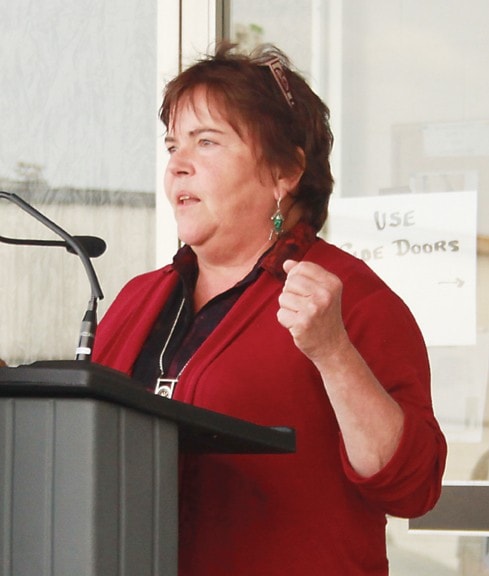Traditionally, local governments in the Cowichan Valley have not turned to public-private partnerships to build the infrastructure they need to provide the services residents want.
That may be about the change.
At the very least, the discussion will soon be taking place as municipal leaders look at the reality of having to replace Cowichan's premier community recreation facility, the Island Savings Centre, as it ages out.
City of Duncan Councillor and Chairperson of the Island Savings Centre Commission Sharon Jackson said fellow commission member North Cowichan Councillor Jen Woike broached the public-private partnership, or P3, question at the commission's last meeting.
"It's something that I think it is our duty to look at," said Jackson. "I'm cautious because I also believe that that's why people pay taxes, is so that we can give them services and there are certain services that people expect and you don't expect to get money back for them, like soccer fields or playgrounds for children.
"We have to have policies around the kinds of public-private partnerships we want and how much public and how much private," she said.
That's the conversation Woike is looking to have.
"I am looking at exploring this idea as a way to generate an additional income resource for the Island Savings Centre," she said, noting that the centre has already benefitted from a $1 million sponsorship deal with Island Savings Credit Union that gave the building its current name.
She would like the commission to explore the possibility of creating new partnerships with the private sector in the future and to create some guidelines as to who the ISC would not be interested in partnering with. Woike also wants to determine if new private partners would be able to lower the residential tax burden while keeping to the commission's five-year financial plan.
The Centre's replacement is another question. It will be a multi-million dollar proposition, as it houses a hockey arena, theatre, library, art gallery, gymnasium and more.
Paying for it is likely to prove a sticky question with taxpayers, as even suggestions that partners start saving now for the replacement costs have met with some resistance.
Mark Romoff, president and CEO of the Canadian Council for Public-Private Partnerships, a national, non-partisan organization with membership from across the public and private sectors, said P3s can be a good way for even relatively small municipalities to take some of the cost and risk away from new infrastructure projects.
"Clearly municipalities are facing significant infrastructure challenges at a time when fiscal constraints are a reality," he said. "That's where publicprivate partnerships have really come to the fore."
There are different kinds of P3s, he said, but the key thing to remember is that at the end of the process, the public will own the building or system that's been created.
"Government always maintains ownership and control," he emphasized. In general, how it works is this: a private sector firm assumes the responsibility for one or more of designing, financing, building, maintaining and operating a facility for a fixed term - usually 20-35 years.
This is a fixed-price contract, so it puts the onus on the private partner to bear the costs if the project goes over budget, for example, so there is pressure to deliver on time and on budget. Results of existing projects have proven that the P3 model can be a big success, said Romoff.
The Council now has a portfolio of over 200 public private partnerships that are either finished or in the works, he said.
Romoff said the communities of Delta, Kelowna, Sidney and even the Town of Goderich, Ont., population 7,500, have benefited from P3s.
A recent press release from the Council also touts the broad economic benefits of P3s to Canada's economy, citing $51.2 billion generated and 290,680 direct full-time equivalent jobs created through P3s between 2003 and 2012.
Romoff cautions that not every project is suited to the public-private partnership model.
The critical feature must be value for money, and if an analysis finds that municipalities can get a better deal if they build in a more traditional way, that's what they should do, he said.
While the most popular types of projects are currently water and wastewater systems, Romoff said, P3s have been used to build everything from a paramedic command centre in Ottawa to a recreation centre in Moncton, NB.
With the pinch of finances and aging infrastructure hitting communities across the country, Romoff said P3s are increasingly on the minds of municipalities of all sizes.
Jackson agreed. The longtime councillor said that while in the past Duncan hasn't gone to the P3 model she can see the topic coming up more and more in the future. "As money gets scarcer and corporations are looking for ways to ingratiate themselves with the public, I have no doubt that this conversation will be coming up more frequently at every level of government," Jackson said.
THE FEDERAL government has created a Crown Corporation, PPP Canada, that can provide advice and guidance on P3 projects. It also has a fund, said Mark Romoff, president and CEO of the Canadian Council for Public-Private Partnerships, that can support qualifying P3 projects. Some of the criteria looked for are delivering value for money, substantial risk transfer to the private sector, and the establishment of public benefits. Find out more about PPP Canada at www.p3canada.ca
NEXT UP in our Beggar's Checklist series, a look at user fees.
